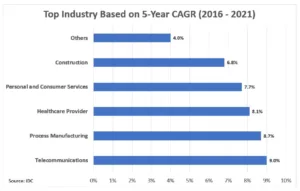Spending on mobility solutions in the Asia Pacific excluding Japan region (APeJ) is expected to grow 5.3% year-on-year in 2018, reaching more than $540.7 billion, according to IDC. This growth is expected to continue through 2021 with spending on mobility-related hardware, software and services surpassing $1.7 trillion as the market achieves a five-year CAGR of 2.8%. IDC’s Avinav Trigunait said:
“
Companies are focusing on improving the user experience by deploying analytical tools, simplifying management with unified endpoint management, creating more employee-focused apps and implementing holistic security solutions. In addition, government support and favourable policies for digital transformation, corporate support for anytime, anywhere working and policies to lure millennials are helping drive overall mobility infrastructure and market development”.
Mobility services is the largest technology group for 2017, accounting for nearly 51% of overall mobility spending and reaching a mark of $285.39 billion in 2021. The category is dominated by mobile connectivity services, which will deliver more than 95% of all mobility services spending. However, enterprise mobility services, which are focused on the planning, implementation, operation, maintenance and support of mobile strategies, applications and devices or the final consumption of services through a mobile device, will see notable spending growth, with a five-year CAGR of 15.8%.
Hardware will be the second-largest technology category with spending recorded at $250.33 billion for 2017. Smartphones will account for roughly 80-85% of all hardware spending throughout the forecast as consumers across APeJ upgrade their mobile phones and enterprises equip their workforce with handheld devices that can run mobile apps and communicate in real time. The smartphone market for APeJ is primarily driven by PRC, which accounted for about 68.21% of market share in 2017, followed by India at 8.84%. The smartphone sector is observing the highest spending growth (4.49%) followed by a modest spending growth (1.45%) in the notebook sector.
Despite being the smallest technology category, software will see strong spending growth (24.29%) over the five-year forecast. Mobile enterprise applications will be the largest segment of mobile software spending, growing to $1.61 billion in 2021. Businesses will focus on managing mobile devices, wireless networks and other mobile computing services, with enterprise mobility management experiencing a five-year CAGR of 30.57%. However, all four software segments, including mobile enterprise security and enterprise mobility management, are forecast to deliver double-digit five-year CAGRs.
Consumers will provide more than 85% of total mobility spending throughout the forecast. Consumer spending is also forecast to slow considerably starting in 2019, when annual growth rates dip below 2%, contributing to a five-year CAGR of 2.66%. The other industries that will see the largest spending on mobility solutions in 2018 are banking ($13 billion), followed by education ($7.49 billion), discrete manufacturing ($6.91 billion) and federal/central government ($6.22 billion). In all four cases, a majority of the spending will go to mobile connectivity services and devices, primarily smartphones and notebook PCs. Enterprise mobility services will also be a significant spending category as these industries implement and execute their mobile strategies. IDC’s Ashutosh Bisht also commented:
“In APeJ, mobility is strongly driven by a new generation of consumers who are embracing the mobile-first world and business models are built around that”.
Trigunait concluded:
“Mobility investment by enterprises is expected to grow at a healthy rate throughout the forecast period, with manufacturing, healthcare, education and public-sector industries as the key drivers. Organisations of medium and very large size will make up around 62% of the mobility spend to improve overall workforce efficiency”.

